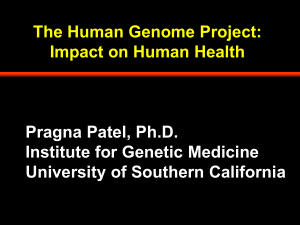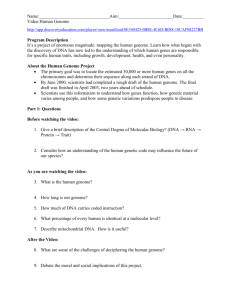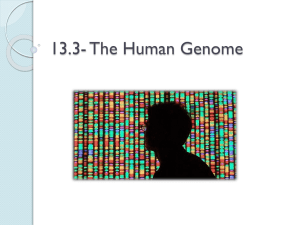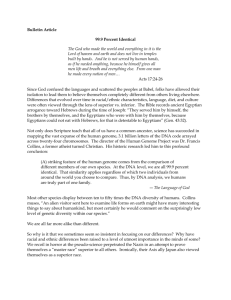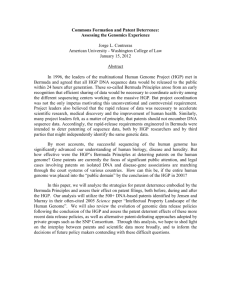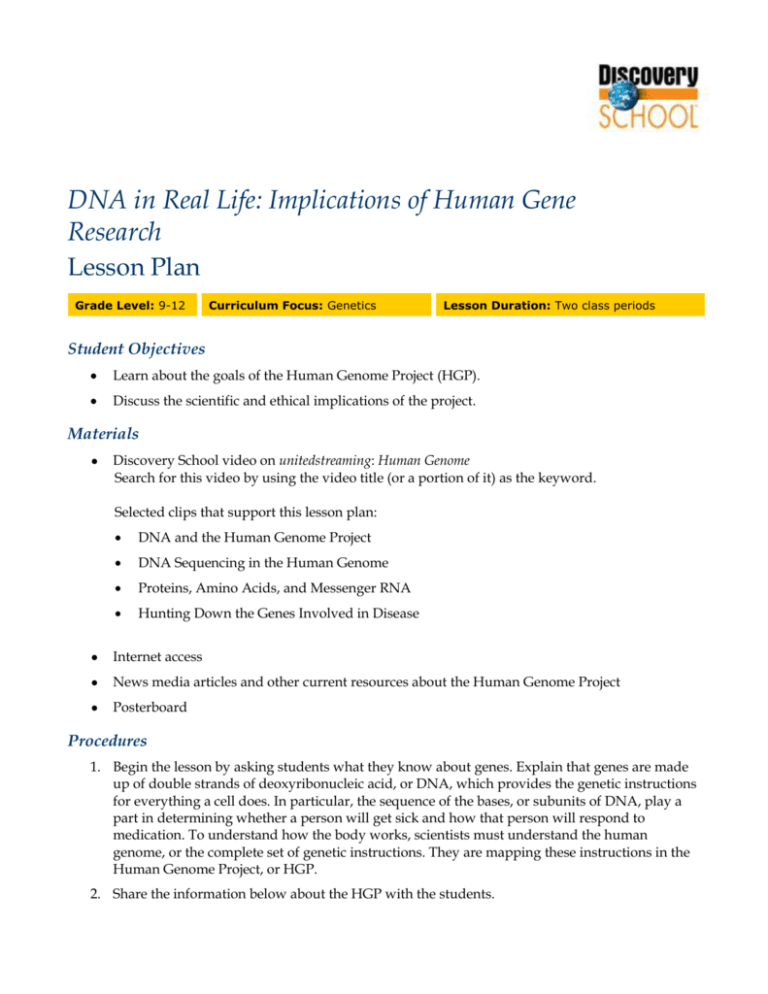
DNA in Real Life: Implications of Human Gene
Research
Lesson Plan
Grade Level: 9-12
Curriculum Focus: Genetics
Lesson Duration: Two class periods
Student Objectives
Learn about the goals of the Human Genome Project (HGP).
Discuss the scientific and ethical implications of the project.
Materials
Discovery School video on unitedstreaming: Human Genome
Search for this video by using the video title (or a portion of it) as the keyword.
Selected clips that support this lesson plan:
DNA and the Human Genome Project
DNA Sequencing in the Human Genome
Proteins, Amino Acids, and Messenger RNA
Hunting Down the Genes Involved in Disease
Internet access
News media articles and other current resources about the Human Genome Project
Posterboard
Procedures
1. Begin the lesson by asking students what they know about genes. Explain that genes are made
up of double strands of deoxyribonucleic acid, or DNA, which provides the genetic instructions
for everything a cell does. In particular, the sequence of the bases, or subunits of DNA, play a
part in determining whether a person will get sick and how that person will respond to
medication. To understand how the body works, scientists must understand the human
genome, or the complete set of genetic instructions. They are mapping these instructions in the
Human Genome Project, or HGP.
2. Share the information below about the HGP with the students.
DNA in Real Life: Implications of Human Gene Research
Lesson Plan
The primary goal was to locate the estimated 30,000 or more human genes on all the
chromosomes and determine their sequence along each strand of DNA.
By June 2000, scientists had completed a rough draft of the human genome. The final draft
was finished in April 2003, two years ahead of schedule.
Scientists use this information to understand how genes function, how genetic material
varies among people, and how some genetic variations predispose people to disease.
2
3. Tell students that the HGP has scientific, ethical, and medical ramifications. During this lesson,
students will work in small groups to research the project. Before students divide into groups,
provide them with an overview of the HGP. The following Web sites will be useful:
http://www.ornl.gov/sci/techresources/Human_Genome/home.shtml
http://www.genome.gov/
4. Divide the class into three groups to research different facets of the HGP. Have them use the
Web sites listed in step 3 to begin their research in the following areas:
Group 1: Scientific findings. The number of genes discovered and their sequence, and
definitions of key scientific terms such as chromosome, DNA, gene, and protein
Group 2: Potential applications. The tools used to detect genes carrying disease and how
this information can be applied to individual treatment plans
Group 3: Ethical implications. Issues involved with screening adults and fetuses for genetic
diseases, using new technology to treat diseases, and others associated with mapping the
human genome
5. Give students time in class to work on their research. Students can record their findings on the
computer or in notebooks. Tell students that they can use illustrations to depict some of their
findings, such as the structure of DNA or the shape of a chromosome.
6. Have each group present its findings. Then have them create displays. Scientific findings could
include a labeled diagram showing the relationships among DNA, genes, chromosomes, and
proteins. Potential applications could be a case study showing how scientists identified the
genes responsible for an illness and how they developed treatment. Ethical implications could
present a list of issues that have emerged from new knowledge.
7. Place the displays on a large piece of posterboard. Use them to discuss the complexity of the
project.
8. Conclude by discussing students’ overall reaction to the Human Genome Project. Do the
advantages outweigh the challenges? Does this information have the potential to save lives:
Assessment
Use the following three-point rubric to evaluate students’ work during this lesson.
3 points: Students exhibited strong research skills; showed above-average ability to compile
findings and present them to the class; demonstrated the ability to share keen insights and
ideas during class discussions.
Published by Discovery Education. © 2005. All rights reserved.
DNA in Real Life: Implications of Human Gene Research
Lesson Plan
2 points: Students exhibited on-grade research skills; showed average ability to compile
findings and present them to the class; demonstrated on-grade ability to share insights and
ideas during class discussions.
1 point: Students exhibited slightly below-average research skills; had some problems in
compiling findings and presenting them to the class; demonstrated difficulty sharing
insights and ideas during class discussions.
3
Vocabulary
chromosome
Definition: A physically separate molecule made up of DNA
Context: DNA in the human genome is arranged into 24 chromosomes.
DNA (deoxyribonucleic acid)
Definition: The chemical inside a cell’s nucleus that carries the instructions for everything the
cell does; made up of four chemical sub-units referred to as bases
Context: The human genome contains 600,000 pairs of DNA.
gene
Definition: The functional and physical unit of heredity passed from parent to offspring
Context: Scientists estimate that human beings each have between 30,000 and 35,000 genes.
human genome
Definition: The complete set of DNA in each human being
Context: Scientists completed a rough draft of a map of the human genome in June 2000.
Academic Standards
National Academy of Sciences
The National Science Education Standards provide guidelines for teaching science as well as a
coherent vision of what it means to be scientifically literate for students in grades K-12. To view the
standards, visit http://books.nap.edu.
This lesson plan addresses the following science standards:
Life Science: Molecular basis of heredity
Science as Inquiry: Understandings about scientific inquiry
Mid-continent Research for Education and Learning (McREL)
McREL’s Content Knowledge: A Compendium of Standards and Benchmarks for K-12 Education
addresses 14 content areas. To view the standards and benchmarks, visit http://www.mcrel.org/.
This lesson plan addresses the following national standards:
Science—Life Sciences: Understands the principles of heredity and related concepts
Published by Discovery Education. © 2005. All rights reserved.
in Real Life: Implications of Human Gene Research
LessoDNA
Lesson Plan
4
n
Language Arts—Viewing: Uses viewing skills and strategies to understand and interpret
Plan:
visual media; Reading: Uses reading skills and strategies to understand and interpret a
variety of informational texts
DNA
in
Real Support Materials
Life: Develop custom worksheets, educational puzzles, online quizzes, and more with the free teaching tools
offered on the Discoveryschool.com Web site. Create and print support materials, or save them to a
ImpliCustom Classroom account for future use. To learn more, visit
cation http://school.discovery.com/teachingtools/teachingtools.html
s of
Hum
an
Gene
Resea
rch
Published by Discovery Education. © 2005. All rights reserved.



